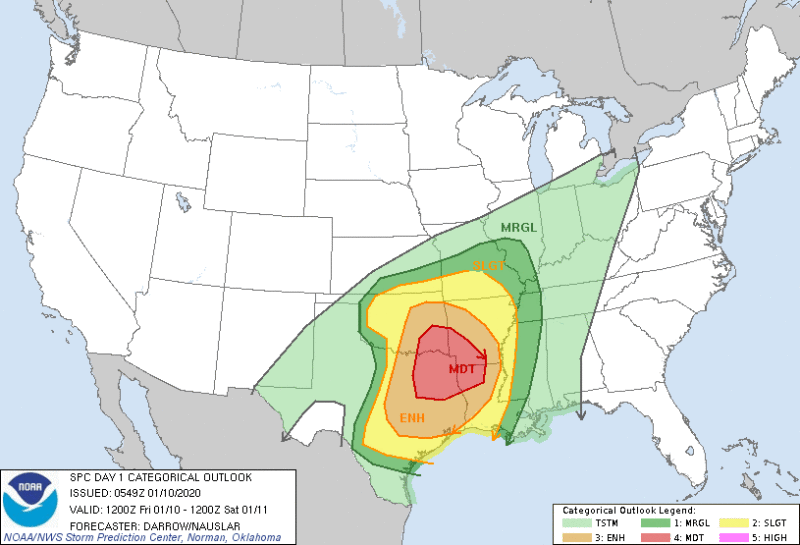Ok, there is a lot to absorb here y’all. Just know the next 24-72 hours if you live in the South, you need to be weather aware. Here’s a brief synopsis before we get into the guts of Winter Storm Isaiah:
- 3″-6″ Ice and Snow tonight from OKC through KC.
- Severe Storms ramp up in Oklahoma and Texas by late morning. These will form a squall line that will cause issues in the Ark-La-Tex area by late afternoon into evening.
- By late night Louisiana, Arkansas, West Tennessee, and West Mississippi are under the gun.
- Tomorrow Tennessee,Alabama, Mississippi, Georgia and the Florida Panhandle and Carolinas are on alert.
- Tornadoes, Straight line winds, large hail, and flash flooding and river flooding are likely with this storm system.
- Yall.com will update this tomorrow morning early for Saturday and Sunday. There is so much going on today we are just going to concentrate on this.
- This is a good time to charge portable cell batteries, check your weather radio battery, or buy one if you don;’t have one.
Now this is the latest from NOAA Storm Prediction Center and NWS:
| Day 1 Risk | Area (sq. mi.) | Area Pop. | Some Larger Population Centers in Risk Area |
| MODERATE | 52,958 | 3,807,360 | Garland, TX…Shreveport, LA…Mesquite, TX…Tyler, TX…Longview, TX… |
| ENHANCED | 102,249 | 18,150,854 | Houston, TX…Dallas, TX…Austin, TX…Fort Worth, TX…Tulsa, OK… |
| SLIGHT | 137,640 | 8,991,892 | San Antonio, TX…Memphis, TN…Oklahoma City, OK…Springfield, MO…Lafayette, LA… |
| MARGINAL | 125,830 | 9,879,922 | Wichita, KS…St. Louis, MO…Corpus Christi, TX…Baton Rouge, LA…Jackson, MS… |
THERE IS A MODERATE RISK OF SEVERE THUNDERSTORMS FROM SOUTHEAST OKLAHOMA INTO THE ARKLATEX... ...SUMMARY... Severe thunderstorms are expected across the southern Plains into the lower Mississippi Valley. Damaging winds are the greatest severe risk, though tornadoes are possible along with very large hail across the southern Plains. ...Southern Plains/Lower Mississippi Valley... Late-evening water-vapor imagery depicts a well-defined short-wave trough over AZ/northern Mexico, shifting east in line with latest model guidance. This feature is forecast to advance into the southern Rockies by 18z as 90+kt 500mb speed max rotates into the base of the trough south of the Big Bend region. In response to this trough, LLJ is forecast to increase across northwest TX which will enhance low-level warm advection across western OK. Low-level moisture is advancing northwest across OK and should aid buoyancy for elevated convection between 12-14z. Forecast soundings suggest elevated supercells are possible early in the period and this is supported by CAMs with a cluster of convection that will spread northeast across northern OK/southern KS. As this activity spreads east into upper 50s/lower 60s dew points, convection will have an opportunity to become surface based, though discrete cells may not be particularly common as a polar front sags into this region. Farther south, strong boundary-layer heating is expected across west TX where surface-3km lapse rates are forecast to approach 9 C/km. At the same time, strong mid-level height falls will spread across the southern Plains by peak heating, and thunderstorms should easily develop along the eastern edge of this steeper lapse-rate plume. Latest thinking is scattered supercells will evolve from east-central OK - north-central TX - southwestern TX between 19-21z. This activity will be strongly sheared and could produce very large hail early in the convective cycle. With time, multi-scale forcing will encourage an extensive squall line that should race east toward the Arklatex region. Damaging winds will likely be common along this squall line as it advances across eastern OK/east TX during the evening hours. Linear MCS will continue east during the overnight hours, advancing to near the MS River toward the end of the period. While damaging winds should be the primary threat with the squall line, very strong shear and moist profiles will likely result in embedded supercells. A few tornadoes are expected along the QLCS but the lack of confidence in discrete pre-frontal supercells will preclude more than 10% tornado probs during the day1 period. Short Range Forecast Discussion NWS Weather Prediction Center College Park MD 302 AM EST Fri Jan 10 2020 Valid 12Z Fri Jan 10 2020 - 12Z Sun Jan 12 2020 ...There is a moderate risk of excessive rainfall over parts of Southern Plains, Middle Mississippi Valley, and Lower Mississippi Valley a long with Moderate risk of severe thunderstorms over parts of the Southern Plains/Lower Mississippi Valley... ...Heavy snow and rain/freezing rain for parts of the Great Lakes and Upper/Middle Mississippi Valley... ...Temperatures will be 10 to 25 degrees above average over the Southern Plains/Lower Mississippi Valley into the Ohio Valley/Great Lakes... ...Heavy snow once again possible in higher elevations of the Northwest... A deep trough over the Rockies will move eastward to the Lower Great Lakes by Sunday. Along the associated front heavy rain will develop from parts of the Southern Plains northeastward to the Great Lakes producing 1 to 3 inches. Due to the slow progression of this system, storm motion will be slow and expected to track over the sames area. This will become become problematic as soils become saturated. A moderate risk of excessive rainfall is forecast over parts of Eastern Oklahoma and neighboring states. The rain will produce numerous flash flooding will occur with many streams being flooded and floods affecting larger rivers. Additionally, the Storm Prediction Center has forecast a Moderate Risk of severe weather for parts of the Southern Plains to Lower Mississippi Valley. On the backside of this system, light to moderate snow over the Intermountain West and Rockies will spread eastward. A wintry mix of snow, sleet, and rain/freezing rain is possible in portions of the Southern/Central Plains into the Middle Mississippi Valley and northeastward into the Great Lakes Friday into Sunday after the cold front drops the temperatures. The heaviest rain/freezing rain is forecast over parts of Great Lakes Saturday into Sunday. A stark temperature gradient will setup over the country thanks to the strong front over the Central U.S. into the Great Lakes. In the warm sector ahead of the front, daily temperatures will average 10 to 25 degrees warmer than typical early January readings. Numerous records are expected to be broken from the Ohio and Tennessee Valleys into the Northeast. In contrast, the western half of the country will be much colder than usual as a cold front and secondary cold front reinforces the frigid airmass. On Friday, high temperatures in the single digits are forecast for the north-central tier of the nation.





